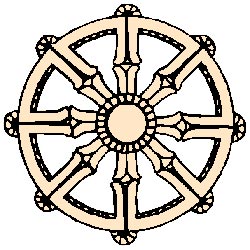While reading
Thich Nhat Hanh’s “The Heart of Buddha’s Teaching”, the practices of The Three
Dharma Seals captured my attention partially because I follow the teachings
already and partially because I still have so much to learn from them. The Three Dharma Seals are impermanence, nonself,
and nirvana. All three work together to
benefit humanity and all of Buddha’s teachings require the presence of the
Three Seals.
 |
| Dharma Wheel |
The importance of impermanence is to understand that nothing lasts forever and to learn to appreciate everything as it is while it is there. Embracing impermanence makes it possible for us to “love [the object] more because we know how to treasure it while it is still alive” (Hanh 131). The idea of nonself stems from impermanence but expands to relate a variety of ideas. As everything changes from moment to moment because of impermanence, the idea of self is changing as well. Understanding nonself means not only acceptance of all, but acceptance of each part of yourself as part of everything else; “we have to see that the one is in the all and the all is in the one” (136). Nirvana ultimately combines the other two Seals and embraces the idea of continuation rather than birth and death. It aims to liberate people from ideas and pushes them to experience more through living in the moment. Hanh explained, “Nirvana teaches that we already are what we want to become. We don’t have to run after anything anymore. We only need to return to ourselves and touch our true nature” (140). By putting the teachings of the Three Dharma Seals into practice, one can find real peace and joy.
 In my life, I have noticed the effort made by many to ignore the idea of impermanence. Children are shielded from the idea for as long as possible to avoid the suffering that is bound to follow. In my opinion, learning about impermanence from Buddha’s perspective could help people to cope with death and change. Until I was a senior in high school, I luckily never experienced the death of someone very close to me. When it did happen, though, it made it that much worse. A friend around my age passed away and wrapping my head around the idea of impermanence was one of the hardest challenges I’ve ever faced. Hanh said, “What makes us suffer is wanting things to be permanent when they are not” (132). Sadness will always follow death, but understanding impermanence would have helped me to focus more on cherishing her life and learning from it. Since then I have learned to embrace every moment and every person and to follow her lead in being a better listener and friend, but understanding impermanence sooner would have completely changed my experiences.
In my life, I have noticed the effort made by many to ignore the idea of impermanence. Children are shielded from the idea for as long as possible to avoid the suffering that is bound to follow. In my opinion, learning about impermanence from Buddha’s perspective could help people to cope with death and change. Until I was a senior in high school, I luckily never experienced the death of someone very close to me. When it did happen, though, it made it that much worse. A friend around my age passed away and wrapping my head around the idea of impermanence was one of the hardest challenges I’ve ever faced. Hanh said, “What makes us suffer is wanting things to be permanent when they are not” (132). Sadness will always follow death, but understanding impermanence would have helped me to focus more on cherishing her life and learning from it. Since then I have learned to embrace every moment and every person and to follow her lead in being a better listener and friend, but understanding impermanence sooner would have completely changed my experiences.
Reading about
the third Dharma Seal, nirvana, also made me think about my own life. Today’s world is so hectic all the time that
living in the moment can become very difficult for me. My mind is always jumping from one thing to
the next and trying to keep up. “Nirvana
means pacifying, silencing, or extinguishing the fire of suffering,” Hanh explains
(140). Embracing the moment and going
with the flow is all that is necessary to live by the teachings of nirvana. Taking time to relax and find peace everyday
and truly understanding nonself and impermanence would benefit my life.
Hanh, Thich Nhat. The Heart of the Buddha's Teaching. New York: Broadway, 1999. Print.
No comments:
Post a Comment